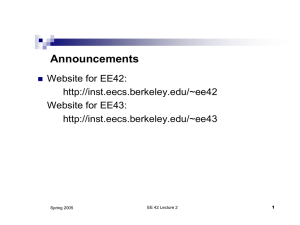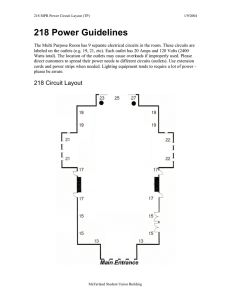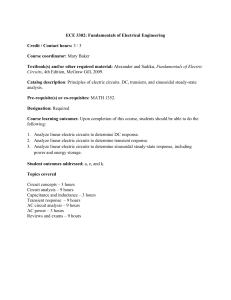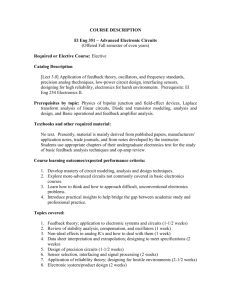Announcements
advertisement
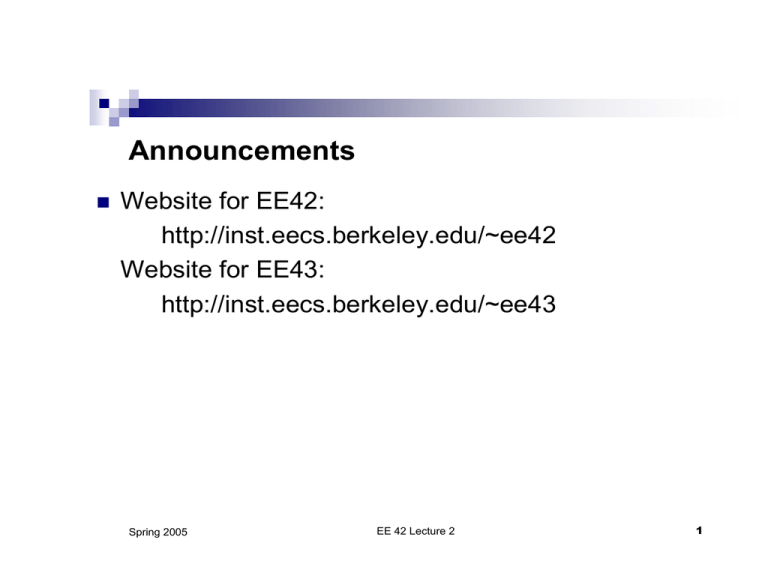
Announcements Website for EE42: http://inst.eecs.berkeley.edu/~ee42 Website for EE43: http://inst.eecs.berkeley.edu/~ee43 Spring 2005 EE 42 Lecture 2 1 Those EE “4x” courses, and EE 100 Course Title Audience Contents EE40 Intr. to Microelectronic Circuits (4 units) EE majors (with 3-hr lab) EE42 Intr. to Electronics for Computer Science (3 units) L&S CS majors (take EE43 lab) EE43 Intro. Electronics Lab (1 unit) EE 42 students (2 hr. lab) Using and understanding electronic lab equipment. Includes an end-ofterm project. EE100 Electronic Techs. for Engineering (4 units) Engineering students other than EECS (with 3 hr. lab) Analysis of circuits, including sinusoidal steady-state response of circuits, operational amplifiers, digital systems, microprocessor control, power systems and machines. (With end-of-term lab project) Fundl. circuit concepts and analysis techniques in context of digital electronic circuits. Includes transient analysis of CMOS logic gates; basic integrated circuit technology and layout. (With end-of-term lab project) Fundl. principles of electronics. Includes impedance and frequency response, digital logic blocks, field-effect transistors, CMOS technology, CMOS logic devices. Some General Comments and Announcements 1. You are encouraged to discuss homework problems with your classmates, as that is a good way to learn. But, you should work your own problems and NOT simply copy those of your mates. Copying of homework, and obviously copying on exams, is not allowed and will be considered a serious transgression. 2. In the lab (EE 43, designed specifically to be taken with EE 42) students work in pairs on the data taking and the report that is turned in at the end of each experiment. It is essential that you read the experiment guide and answer the pre-lab questions before coming to the lab – there isn’t time to learn about the lab and complete it in the two-hour lab period itself. 3. Discussion sections will begin in the second week of the term. 4. You are welcome to go to any discussion that suits you. The GSIs will generally present similar topics but in different ways – you might “shop around” to find a presentation style that suits you best. 5. A number of different topics will be encountered in the lab experiments. You’ll learn how to use the common tools for making electrical measurements (multimeters, oscilloscopes, function generators); you’ll do experiments with various kinds of diodes (ordinary rectifying diodes you’d find in electronic circuits, light-emitting diodes, even solar cells); standard circuits such as those employing just a resistor and a capacitor and an energy source, integrated circuit logic gates, such as NAND gates, the transistor workhorse of digital electronics, the MOSFET, and some new devices – Smart Dust wireless sensor platforms. There will be an end-of-term project – likely building a music system with an AC/DC converter to power it, tone control circuitry and an amplifier – that you can take home after the term is over. We’ll also introduce you to the use of commercial software used in industry and academic research labs to run conventional measurement equipment and take data for analysis and display (LabVIEW, made by National Instruments, Inc.) 6. Your textbook, “Electrical Engineering: Principles and Applications”, by Hambley, contains a number of descriptions of applications of electrical engineering (note the one describing how the yellow line showing where the first-down marker is appears on football TV broadcasts). The book also contains two CDs with answers to problems and two other items of note: A program (Orcad) for drawing circuits from simple to complex) and an analysis program (PSpice) that you can use to analyze circuits, plot their response, etc. The Spice family of circuit analysis programs, which have an integrated circuit emphasis, are used and highly regarded worldwide. The programs were created at Berkeley starting in the 1960s by Prof. Don Pederson, recently deceased, who insisted that the programs be made available free to users, with the request that they report back any innovations they made in it – a very early and important open-source example. Some Examples of EE Systems, Circuits, and Devices From computers to individual devices Analog vs. digital Digital telephone system From computers to individual devices Analog vs. digital Digital telephone system
